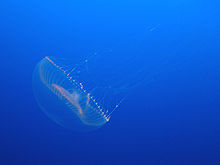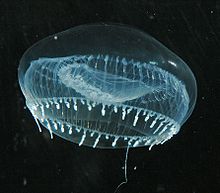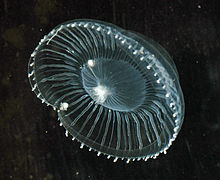Aequorea victoria
| Aequorea victoria | |
|---|---|

| |
| Scientific classification | |
| Kingdom: | |
| Subkingdom: | |
| Phylum: | |
| Subphylum: | |
| Class: | |
| Subclass: | |
| Order: | |
| Suborder: | |
| Family: | |
| Genus: | |
| Species: | A. victoria
|
| Binomial name | |
| Aequorea victoria | |





Aequorea victoria, also called the crystal jelly, is a bioluminescent jellyfish that is found off the west coast of North America. This species is thought to be synonymous with Aequorea aequorea of Osamu Shimomura, the discoverer of green fluorescent protein. Shimomura together with Martin Chalfie and Roger Y. Tsien were awarded the 2008 Nobel Prize in Chemistry for the discovery and development of this protein as an important biological research tool. Originally the victoria species was supposed to designate the variant found in the Pacific and the aequorea designation was used for specimens found in the Atlantic and Mediterranean. The species name used in GFP purification was later disputed by Arai and Brinckmann-Voss (1980) who decided to separate them on the basis of 40 specimens collected from around Vancouver Island. Osamu Shimomura notes that this species in general shows great variation and from 1961 to 1988 the Friday Harbor Laboratories of University of Washington collected around 1 million samples and in many cases there were pronounced variations in the form of the jellyfish.
Description
Almost entirely clear and sometimes difficult to resolve, Aequorea victoria possess a highly contractible mouth & manubrium at the center of up to 100 radial canals that extend to the bell margin. The bell margin is surrounded by up to 150 uneven tentacles in full-grown specimens. The tentacles possess nematocysts that aid in prey capture, though they have no effect on humans. Specimens larger than 3 cm frequently possess gonads for sexual reproduction (visible in all photos), which run most of the length of the radial canals. The bell margin is ringed with a small velum, typical of most hydromedusae, which aids in locomotion through muscular contraction of the bell. Larger specimens are frequently found with symbiotic amphipods attached to the subumbrella.
Species Range
Aequorea victoria are found along the west coast of the Pacific ocean from the Bering Sea to southern California. A pelagic organism, it can be found floating and swimming both nearshore in the Puget sound, as well as offshore in the eastern Pacific Ocean[1].
Misidentifications
Aequorea victoria can be mistaken for other species from the Aequorea genus, notably Aequorea coerulescens. While this species is found generally offshore in the eastern Pacific Ocean, rare specimens have been collected in central California and in Friday Harbor, North Puget Sound[2]. While morphologically very similar to Aequorea victoria, Aequorea coerulescens is roughly the size of a dinner plate with many more radial canals.
Life History
Aequorea victoria have a dimorphic life history, alternating between asexual benthic polyps and sexual planktonic medusae in a seasonal pattern[3]. Aequorea victoria juvenile medusae are asexually budded off hydroid colonies in early spring, and soon become free-living hydromedusae. The medusoid spends its first stage of life growing quickly, and after reaching approx. 3 cm will begin producing gametes for sexual reproduction. These eggs are free-spawned into the water column around mid-August, where they eventually settle out to form a new hydroid colony. These thrive on hard or rocky substrates on the bottom, where they hibernate until an unknown cue spurs them to continue the cycle with a new generation. The medusa form generally lives approximately 6 months[4].
Natural History
Aequorea victoria typically feed on soft-bodied organisms, including zooplankton such as copepods, crab zoëals, barnacle nauplii & other larval planktonic organisms. Gelatinous organisms consumed include ctenophores, appendicularians and other hydromedusae, including other Aequorea victoria if conditions are appropriate[5]. Prey is ensnared in long tentacles containing nematocysts, and eaten with a highly contractile mouth that can expand to consume organisms half the medusae’s size. Due to their voracious nature, Aequorea victoria density can be inversely correlated to zooplankton density, indicating a competitive presence in shared environments[5].
Predators
They are eaten by the voracious scyphozoa Cyanea capillata, commonly called the Lion’s Mane Jelly, as well as ctenophores, siphonophora and other hydromedusae, including documented cases of cannibalism[5]. Many larger specimens are found with the parasitic hyperiid amphipod Hyperia medusarum attached to the subumbrella.
Luminescence
This jellyfish is capable of producing flashes of blue light by a quick release of calcium (Ca2+) which interacts with the photoprotein aequorin. The blue light produced is in turn transduced to green by the now famous green fluorescent protein (GFP). Both aequorin and GFP are important tools used in biological research.
Shimomura and Johnson, in 1961, isolated the protein aequorin, and its small molecule cofactor, coelenterazine, from large numbers of Aequorea jellyfish at Friday Harbor Laboratories[6]. They serendipitously discovered, after initially finding bright luminescence on adding seawater to a purified sample, that calcium ions (Ca2+) were required to trigger bioluminescence. This research also marked the beginning of research into green fluorescent protein which was summarized by Shimomura.[6] Ridgeway and Ashley (1967) microinjection aequorin into single muscle fibers of barnacles, and observed transient calcium ion dependent signals during muscle contraction.
For his research into GFP, Osamu Shimomura was awarded the 2008 Nobel Prize for chemistry, together with Martin Chalfie and Roger Tsien. [7]
Footnotes
- ^ Kozloff, Eugene N.. Marine Invertebrates of the Pacific Northwest. 2nd. Seattle: University of Washington Press, 1996.
- ^ Mills, C.E. 1999-present. “Bioluminescence of Aequorea, a hydromedusa.” Electronic internet document available at http://faculty.washington.edu/cemills/Aequorea.html. Published by C. E. Mills, web page established June 1999, last updated (15 February 2007).
- ^ Brusca, Richard C., and Brusca, Gary J. Invertebrates. 2nd. Sunderland, MA: Sinauer Associates, Inc., 2003.
- ^ Mills, C.E. 1999-present. “Bioluminescence of Aequorea, a hydromedusa.” Electronic internet document available at http://faculty.washington.edu/cemills/Aequorea.html. Published by C. E. Mills, web page established June 1999, last updated (15 February 2007).
- ^ a b c Purcell, Jennifer E.. "Predation by Aequorea victoria on other species of potentially competing pelagic hydrozoans." Marine Ecology Progress Series 72(1991): 255-260.
- ^ a b Shimomura O (1995). "A short story of aequorin". The Biological bulletin. 189 (1): 1–5. PMID 7654844.
{{cite journal}}: Unknown parameter|month=ignored (help) - ^ BBC report
